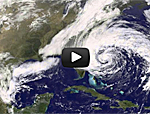As the storm that was Hurricane Sandy weakened over Pennsylvania, NASA released a timelapse animation of the lifespan of the massive storm, tracking its path from the Caribbean, where it developed, to its violent landfall on the mid-Atlantic coast of the U.S. The collection of images, taken by the NASA GOES-13 satellite from Oct. 23 to Oct. 31, illustrates the storm gaining intensity as it traveled north, at times reaching nearly 1,000 miles in width. When the storm reached the mid-Atlantic on Oct. 29, it became wedged between a cold front over the Appalachian Mountains and a high-pressure air mass over maritime Canada, preventing it from moving north or east and instead driving it ashore. At that point Sandy became a Nor’easter, triggering historic storm surges in coastal areas of New York and New Jersey and blizzard conditions in the mountain regions. Meteorologists say the swath of high winds produced by Sandy while it was a hurricane covered nearly 2 million square miles.
Timelapse of Hurricane Sandy Shows Birth and Death of Historic Storm
More From E360
-
Energy
Why U.S. Geothermal May Advance, Despite Political Headwinds
-
Food & Agriculture
In War Zones, a Race to Save Key Seeds Needed to Feed the World
-
Climate
Lightning Strikes the Arctic: What Will It Mean for the Far North?
-
RIVERS
A Win for Farmers and Tribes Brings New Hope to the Klamath
-
Solutions
Deconstructing Buildings: The Quest for New Life for Old Wood
-
NATURAL DEFENSES
How Restored Wetlands Can Protect Europe from Russian Invasion
-
Solutions
Birds vs. Wind Turbines: New Research Aims to Prevent Deaths
-
FORESTS
Cambodian Forest Defenders at Risk for Exposing Illegal Logging
-
OPINION
The ‘Green’ Aviation Fuel That Would Increase Carbon Emissions
-
CONSERVATION
Out of the Wild: How A.I. Is Transforming Conservation Science
-
Energy
China’s Mega Dam Project Poses Big Risks for Asia’s Grand Canyon
-
Solutions
How Natural Solutions Can Help Islands Survive Sea Level Rise
